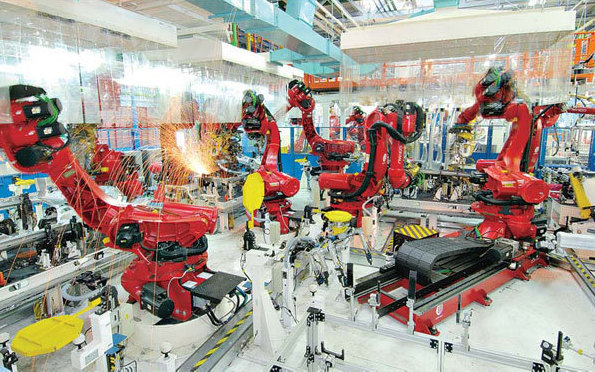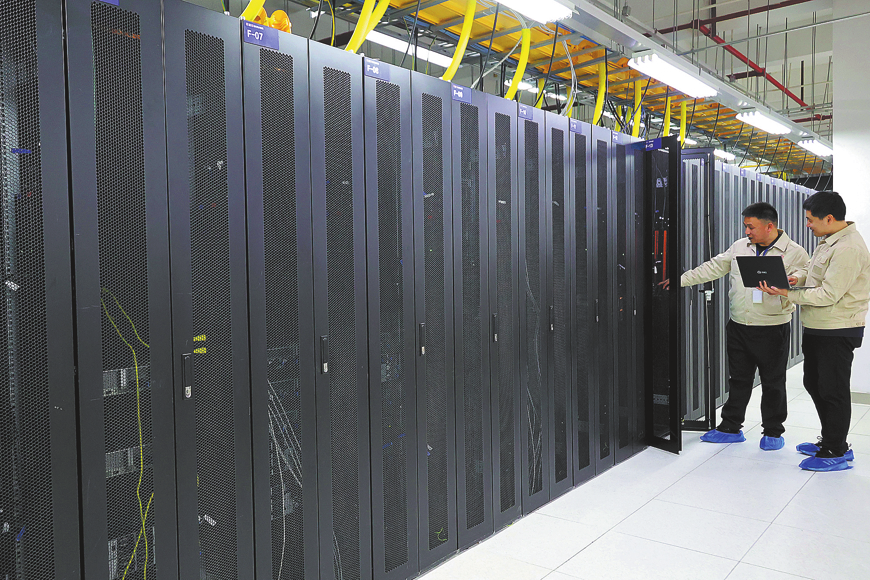Products managed from cradle to grave

| An engineer of Consorsio Macchine Utensili, an automobile manufacturing line producer and a user of Siemens PLM Software, uses it in designing products and in simulation experiments. Provided for China Daily |
China looms as huge market for software overseeing products, says automation executive
Chuck Grindstaff, an American who runs a German-backed industry automation company, sees China as his biggest market over the next decade for a software called lifecycle management that acts as a guardian of a product.
The chief executive officer of Siemens PLM Software says China will be the company's top buyer of its products in 10 years, although some Western entities are moving manufacturing plants back home.
"China is moving to a later stage of growth of high value and high quality manufacturing and an environment where innovation and engineering and creation of its own products are growing," says Grindstaff.
As more local companies start to understand the importance of innovation and cost control, Siemens PLM plans to gain more Chinese customers from next year.
The Plano, Texas-based company, develops software used to manage the entire lifecycle of a product from designing, manufacturing, to deployment and disposal.
Machinery manufacturing is the best sector to showcase PLM software.
Engineers and designers can use PLM software to build a yacht using a computer and send the blueprint to a shipyard. Workers at the shipyard will use the same system to monitor the building process and cut short the manufacturing time. Decorators can also use the PLM software to decide on the best time to move in the furniture so work on the floors won't be interfered with.
Even after the yacht is handed over to its owner, the lifecycle management software can continue to oversee the sea-worthiness of the boat and tell the sailors which parts need attention.
Following the same idea, PLM can be used in almost all manufacturing industries from space engineering to making shoes.
Chinese manufacturing companies, known for their high labor intensity and low development input, will be able to focus on product design and innovation and hire fewer entry-level workers on the front line, says Christopher Holmes, head of Asia-Pacific IDC Insights of Singapore.
PLM's turnover in China reached $1.16 billion in 2012, representing a year-on-year increase of 16.2 percent, according to a Siemens estimate.
Yet PLM systems are severely underrepresented in the world's second-largest economy famous for its role as the world's factory.
China accounted for 3.5 percent of the overall share of the global comprehensive PLM market last year.
The country's export-oriented economy has been hit by the global economic downturn since 2008.
"China needs to build an innovation-driven manufacturing industry to put more added-value into its exports," Holmes says.
Traditional manufacturers in China will require new technology to keep their global competitiveness, he says.
According to a HSBC Holdings Plc report, China's manufacturing Purchasing Managers' Index, a gauge of domestic manufacturing activity, may decrease in December from an eighth-month high in November.
Data from the National Bureau of Statistics indicated the manufacturing PMI was 51.0 last month, the lowest in 2013.
"Because China's economy remains export-oriented, the employment rate and earnings in the private sector are closely related to the global economic atmosphere," says Holmes, adding that because the European Union and other major trade partners of China are still in recession, Chinese firms need better cost-control and higher quality.
More vertical sectors, such as healthcare and digital manufacturing, will need a PLM system to boost work efficiency, says Grindstaff.
"The global economy is kind of funny right now. The weather is changing on a daily basis. This does put some pressure on the timing of the projects but our business has been quite strong around the world."
"For us, it's the value that we can provide after the implementation and we are trying to lower the cost barrier to get more implementation," he says.
"As China is moving to further develop its aerospace and commercial jetliners, I would like to show our tools to the large number of potential customers in China."
Grindstaff joined the company in 1978 when it was known as Unigraphics Solutions. He held a number of research and development positions during his first 10 years with the organization.
He subsequently left the company to serve as president and chief executive officer of Waveframe Corp, a developer of digital signal processing systems for high-end motion picture applications.
He returned to Unigraphics in 1994. After the company was acquired by Siemens AG, he became company CEO in October 2011.
The 56-year-old, who enjoys skiing, sailing, cycling and hiking, now lives in Dallas, Texas.
He says that because of the increasing cost of logistics and shipping, manufacturing is shifting back to the US and other developed economies, a process that started last year.
Apple Inc, the California-based electronics giant, has moved its Mac personal computer product lines back to the US from various locations abroad; Companies such as K'Nex Industries Inc, the toy manufacturer Trellis Earth Products Inc, a maker of bioplastic goods; and bra maker Handful Inc have announced plans to shift production from China to the US, according to the British newspaper Financial Times.
Lower-end businesses are also bypassing China and pouring into neighboring countires such as Vietnam and Cambodia because labor costs are lower.
As the price of labor in China continues to increase, China is facing a similar problem to those developed economies encountered decades ago. "The challenge of any developed manufacturing environment is how to get repeatable quality and productivity. It is not simply about cheap labor," Grindstaff says.
The country is making the same kind of transition as others: trying to raise automatiion and reduce labor costs, he says.
"A similar thing has happened in Germany and the US, where they are automating their way out of high labor costs. I think China will do the same thing."
Grindstaff says he believes China is "way too smart" to ride only on the shoulders of cheap labor. And the trick is to let the talented in China look at the world and look at the opportunities and begin to innovate a little bit more.
Analysts says the economically developed part of China is ready for such changes because the regions have fully embraced market competition rules.
It is impossible for China to adopt the PLM concept nationwide, says Holmes from IDC. Some developed coastal areas and multinational enterprises are already starting to deploy PLM software but the adoption rate in less developed inland regions remains low.
Local companies such as automaker China FAW Group Corp, steel maker Baosteel Group Co Ltd and home appliance makers Changhong Electric Co Ltd and Haier Group were Siemens PLM's major customers in China.
New technology is more important for Chinese consumer product makers such as shoe plants, says John Johnson, senior global director at Siemens PLM, who heads consumer products and retail industries.
Although China produces about 90 percent of shoes sold globally, it is losing the key to the footwear kingdom because of increasing competition from other Asian countries.
Johnson estimated India and Vietnam will produce about 3.5 billion shoes by 2016 while China will make fewer than 7 billion.
"India and Vietnam are the new sleeping giants in the footwear industry," he says.
As an increasing number of higher-end manufacturers in China start to adopt PLM, smaller companies are set to join the trend in the coming years, Grindstaff says.
"The change is happening now. The rest of China can learn from industry leaders. The adoption of a PLM system does not necessarily occur in a typical Chinese way - everybody at the same time. It will happen based on market demand."
PLM software will be a perfect tool for companies that are creating "world-class innovations" and China could be the biggest "greenhouse" for such innovations, he says.
gaoyuan@chinadaily.com.cn
(China Daily European Weekly 01/10/2014 page21)
Today's Top News
- Takaichi must stop rubbing salt in wounds, retract Taiwan remarks
- Millions vie for civil service jobs
- Chinese landmark trade corridor handles over 5m TEUs
- China holds first national civil service exam since raising eligibility age cap
- Xi's article on CPC self-reform to be published
- Xi stresses improving long-term mechanisms for cyberspace governance































